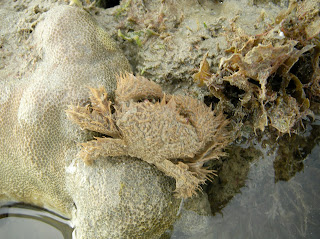I've never blogged about the Creeper Snails (Cerithium spp.) before, in fact I rarely introduce them to visitors. These poor forgotten snails are the living vacuum cleaners of our shores, sweeping the mud for detritus as food. They are abundant along sandy and slightly muddy shores because they never run out of food! How lucky!
The seeds from the mangrove plant germinates while its on the tree, unlike the seeds of other plants. It forms a propagule and drops in the water once it matures and is ready to lead an independent life away from its parent. Initially, the elongated propagule floats horizontally but over time, it floats vertically after the roots gains weight from the absorbtion of water. Eventually, it takes root after locating a comfortable and suitable environment, just like the propagule in this photo.
We were separated into 2 big groups, and I was to start with the Seagrass team first. Before the training commences, the 'older' volunteers embarked on the mission to find all 6 species of seagrass. Heres five of them, namely, 1) Enhalus acoroides , 2) Cymodocea serrulata, 3)Thalassia hemprichii, 4) Halodule uninervis and 5)Syringodium isoetifolium, laid neatly on the ground.
The 6th species is too small to be seen from the photo, heres a closeup shot of Halophila Ovalis - the Spoon Seagrass, which I have never recorded in all my past transects....heh heh.. hopefully its because it doesnt grow at our transect area!
The training first started with the challenging task of identifying the different species of seagrass. Patiently, we went through species by species to recognise how each of them looks like. The key differences between the species were also highlighted.
Here is a group comparing the actual sea grass vs the photo on the ID chart. Honestly, I must say this is really effective training. 1 year ago, we didnt have the luxury of a trial hands-on training. Identification of the sea grasses gave us much grief initially because we could not visualise how each species look like and thus had much difficulty looking out for them in subsequent transects.
Next was a step-by-step guide on how to conduct the transect - laying the measuring tape from left (shore on our left) to right, placing the quadrat at the right mark, identifying the species and its % cover , epiphyte cover, canopy height, algae species and % cover, fruits & flowers.
The group then dispersed into smaller teams of two/ three for an on-the-job training.
As we wade through the lagoon, we noticed that the water is speckled with many tiny white male flowers of the tape seagrass. A really good sign! The 'older' volunteers were also fed the seeds of the tape seagrass which taste almost like chestnut - thankfully I'm still sitting here, typing away... =)
After an hour, it was time to switch to the 2nd part of training - Line Intersect Transect. As we walked towards LK, we tread past the Sandsifting Sea Star / Common Sea Star (Archaster typicus) lagoon. Heres a four-armed seastar! One of the volunteers thought this seastar had lost an arm - although seastars are more commonly seen with 5 arms, there are those with 4 arms or > 5 arms as well.
Marks left behind by the Common Sea Stars - 凡走过必留下衡迹 applies not only to human beings!
After a round of explanation by LK on how to differentiate the LIT codes, the IDs and how to fill up the form, we spread out to start our trial LIT transect. I forgot to take any photos of LK's training because I was listening intently - I've never done a single LIT transect in the past year! Which is also why, ironically, I find the seagrass transect so much easier.
Zoanthids that were in our path during the LIT. Zoanthids are colonial anemones and have small polyps linked to each other. During high tide, their tentacles are extended to catch preys. I remember during one of the hunting seeking survey which Hazel and I were assigned to survey corals and sponges, we thought Zoantids were corals, and Ascidians were algae! *slaps forehead*
In one of the tidal pools, we saw 2 Sunflower Mushroom Coral (Heliofungia sp.). Often mistaken as a Sea Anemore or a soft coral, the Sunflower Mushroom Coral is actually a hard coral which you can tell from its hard skeleton in the middle. Unlike other hard corals, the Sunflower Mushroom Coral is a single living animal that is free-moving. They come in brown or green colours due to the presence of zooxanthallae. While it does not look like a mushroom now, it comes with a stalk and is stuck to a substrate when it is younger, looking just like a mushroom!
After 2 LIT trial transects, we had about 30mins to do a miniature hunting seeking survey. Our group must be quite lucky to see a few Worm-Eels (Muraenichthys sp.) as they are usually active at night. In addition, I had more than enough time to snap many shots of it. Typically, sightings of it are usually brief as they disappear rather quickly into some holes. Without scales and pectoral fins, they really look like a worm or sea snake with its long tubular body and the way it swims.
A regular sighting at Semakau, this trip was no exception. The Hairy Crab (Pilumnis vespertilio) was still very well-camouflaged and took my teammates some time to spot it.
My first sighting of a Hammer Oyster (Malleus sp), and I went on to see 2 more after LK pointed this one out to me. Unfortunately, the photo I took was not clear enough to depict the essence of its name (no prizes on how it got its name). The two-part shell is thick and T-shaped, looking just like a hammer.
We also saw a few Black-lipped conches (Strombus urceus). Similar to its Spider Conch cousin, the Black-lipped conch also has a strong mascular operculum that helps it pole vault around. I learnt that this conch is on our red list of threatened animal - probably due to the lost of habitat and over collection of its shells.
As I was taking the photo of the Black-lipped conch, Weihan called out to me and shouted 'Stonefish' - gave me a shock! The words 'Sea Cucumber' came 5 seconds later after he realised what he had said. Yup, this is a Stonefish Sea Cucumber (Actinopyga lecanora), looking just like a loaf of bread to me, although many will compare it to a smooth stone - how it looks like when it bloats up into a rounded, smooth shape, apparently when disturbed.
Look at its tube feet sparsely spread out on its body!
We also saw a really big Flatworm (Acanthozoon sp.) about 10cm long! This is the animal that I blanked out when I guided the day before..keke.. Flatworms are really flat and thin and can move into any small crevices. Oxygen diffuses through its body, thus it does not have a respiratory or circulation system. Many flatworms are carnivores and prey on tiny animals by injecting digestive juices into the prey. It then sucked up the liquefied meal.
Marine flatworms are hermaphrodites, that is, each flatworm has both the male and female reproductive organs. Just like human beings, they must find carrying a baby extremely tiring and laborious. Thus some species of flatworm tries to impregnate the other and results in 'penis-fencing' when the two flatworms meet. Amazingly, some species can impregnant each other simply by insert their penis in any part of the body!
Soon, tide was rising and water was becoming murky. We quickly walked towards the shore and along the way, I peeped into the rock where I saw the 2 octopuses the day before. Guess what, one of them was still there (looks like the same one to me)! I bet it had moved during the 24 hrs but being the smartest invertebrate, it recognised its track back to the same hiding place. Its other partner was nowhere to be seen though.
My last sight before leaving the intertidal area was this Fan worm. The head of this segmented worm has feather-like arms, and look just like a mini feather duster. These arms filters the water for plankton or detritus. They live in a flexible tube that is made of sand, their own saliva and mucus (reusing its existing materials, how very environmental-friendly!) which they hide into ,the minute they sense danger. The tubes also keep them moist and safe on occasions when they are exposed at low tide
Although it was a revision of the survey techniques, there were still many new things learnt. Also glad that I had a few first sightings (thankfully don't have to pay the person who pointed out these animals to me, unlike the first sighting of birds, else I'll be totally broke very soon).























1 comment:
[url=http://plain.reira.ru/index88.html]russian beautiful nude woman[/url] [url=http://plain.reira.ru/russian-caned-girls.html]russian caned girls[/url]
Post a Comment